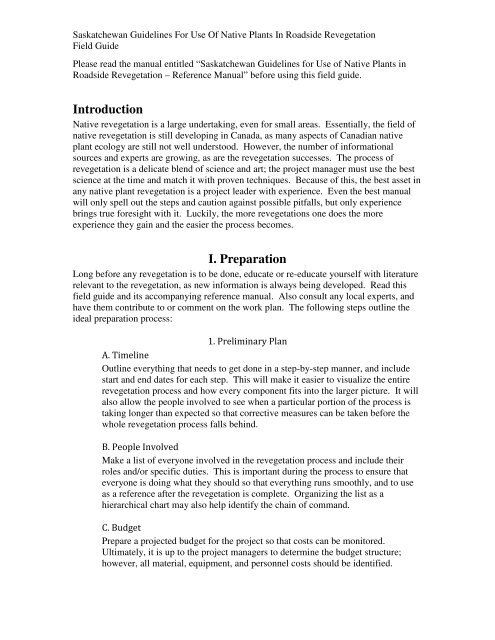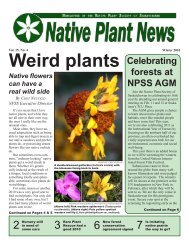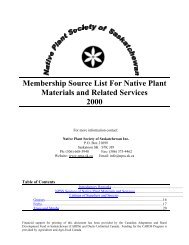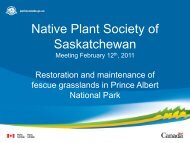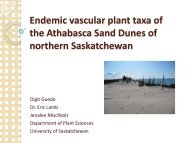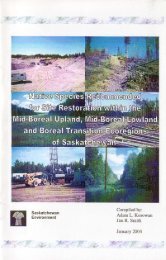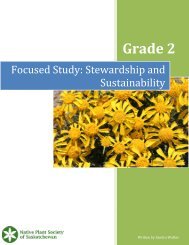Saskatchewan Guidelines For Use Of Native Plants In Roadside ...
Saskatchewan Guidelines For Use Of Native Plants In Roadside ...
Saskatchewan Guidelines For Use Of Native Plants In Roadside ...
You also want an ePaper? Increase the reach of your titles
YUMPU automatically turns print PDFs into web optimized ePapers that Google loves.
<strong>Saskatchewan</strong> <strong>Guidelines</strong> <strong>For</strong> <strong>Use</strong> <strong>Of</strong> <strong>Native</strong> <strong>Plants</strong> <strong>In</strong> <strong>Roadside</strong> Revegetation<br />
Field Guide<br />
Please read the manual entitled “<strong>Saskatchewan</strong> <strong>Guidelines</strong> for <strong>Use</strong> of <strong>Native</strong> <strong>Plants</strong> in<br />
<strong>Roadside</strong> Revegetation – Reference Manual” before using this field guide.<br />
<strong>In</strong>troduction<br />
<strong>Native</strong> revegetation is a large undertaking, even for small areas. Essentially, the field of<br />
native revegetation is still developing in Canada, as many aspects of Canadian native<br />
plant ecology are still not well understood. However, the number of informational<br />
sources and experts are growing, as are the revegetation successes. The process of<br />
revegetation is a delicate blend of science and art; the project manager must use the best<br />
science at the time and match it with proven techniques. Because of this, the best asset in<br />
any native plant revegetation is a project leader with experience. Even the best manual<br />
will only spell out the steps and caution against possible pitfalls, but only experience<br />
brings true foresight with it. Luckily, the more revegetations one does the more<br />
experience they gain and the easier the process becomes.<br />
I. Preparation<br />
Long before any revegetation is to be done, educate or re-educate yourself with literature<br />
relevant to the revegetation, as new information is always being developed. Read this<br />
field guide and its accompanying reference manual. Also consult any local experts, and<br />
have them contribute to or comment on the work plan. The following steps outline the<br />
ideal preparation process:<br />
1. Preliminary Plan<br />
A. Timeline<br />
Outline everything that needs to get done in a step-by-step manner, and include<br />
start and end dates for each step. This will make it easier to visualize the entire<br />
revegetation process and how every component fits into the larger picture. It will<br />
also allow the people involved to see when a particular portion of the process is<br />
taking longer than expected so that corrective measures can be taken before the<br />
whole revegetation process falls behind.<br />
B. People <strong>In</strong>volved<br />
Make a list of everyone involved in the revegetation process and include their<br />
roles and/or specific duties. This is important during the process to ensure that<br />
everyone is doing what they should so that everything runs smoothly, and to use<br />
as a reference after the revegetation is complete. Organizing the list as a<br />
hierarchical chart may also help identify the chain of command.<br />
C. Budget<br />
Prepare a projected budget for the project so that costs can be monitored.<br />
Ultimately, it is up to the project managers to determine the budget structure;<br />
however, all material, equipment, and personnel costs should be identified.


